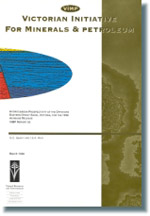VIMP Report 55 - Hydrocarbon prospectivity of the offshore eastern Otway Basin, Victoria, for the 1998 Acreage Release
 |
| |||||
Product description:Download The downloadable version of this report is supplied in PDF format. Executive Summary The study area comprises Commonwealth blocks V98-2, V98-3 and V98-4 and State coastal blocks 98-O2(V), 98-O3(V) and 98-O4(V). These blocks collectively cover most of the prospective acreage in the offshore Victorian sector of the eastern Otway Basin. The area lies directly offshore from the Port Campbell Embayment where several commercial onshore gas discoveries have been made, and surrounds the offshore Minerva and La Bella gas fields. It is located some 300 km west-southwest of Melbourne. Water depths are generally less than 100 m but increase to over 1,000 m in the southwestern part of V98-3. Eleven (11) exploration wells have been drilled in the study area resulting in two significant gas/condensate discoveries in 1993: La Bella (GIP: 210 Bcf) and Minerva (GIP: 575 Bcf). The first offshore well drilled in the Otway Basin in 1967, Pecten-1A, provided a small gas flow from the Waarre Formation. However, the early wells were located with poor-quality seismic data and most were drilled off-structure. Of the seven recent wells drilled by BHP Petroleum between 1993 and 1995, three were gas/condensate discoveries while five failed for various reasons. Both Eric the Red-1 and Loch Ard-1 were unsuccessful due to the absence of Belfast Mudstone seal over the Prawn Platform. Conan-1 is interpreted to lack cross-fault seal while Champion-1 drilled the crest of a Late Cretaceous faulted anticline where only a remnant, non-reservoir Waarre section was present. The area is covered by an excellent regional to semi-detailed grid of recent (post-1990) and older reprocessed 2D seismic data. Data quality is variable and most would benefit significantly from reprocessing. The three blocks in State coastal waters possess only sparse seismic coverage with most representing line ends. A 3D seismic grid lies over the Minerva gas field but this was not incorporated into the study. The Otway Basin developed as a rift to passive margin basin that was initiated in the Late Jurassic with failed Oxfordian to Albian rifting. Following major mid-Cretaceous tectonism, crustal extension was re-established in the Turonian leading to continental break-up in the latest Maastrichtian. Tertiary to Recent passive margin development followed with the progressive separation of Antarctica from Australia and evolution of the Southern Ocean. The whole of the prospective Upper Cretaceous Sherbrook Group containing the important Waarre reservoir unit is now considered to be a syn-rift sequence. This has important implications with regard to both structural and stratigraphic development of the basin. All the major structural features of the offshore Otway Basin including the Mussel Platform, Shipwreck Trough, Prawn Platform and Voluta Trough evolved primarily through Late Cretaceous rifting. Importantly, syn-rift development of N-S anticlinal and synclinal transpressional folds has led to the identification of a new structural trap type defined by faulted anticlines. Structuring at both the La Bella and Minerva fields shows elements of this transpressional folding and a significant number of other untested, faulted anticlinal structures are seen on seismic across the area. Late Cretaceous transpressional folding has not been recognised in previous interpretations through a combination of poor seismic data quality, the application of inappropriate structural models and because the folding is often obscured by overprinting of Late Tertiary compressional folds. The folding formed as a consequence of Late Cretaceous rifting where NE-SW directed crustal extension, acting obliquely on N-S basement lineaments or zones of weakness, imparted an E-W component of compression. Structuring was syn-depositional and exerted major control on the distribution and stratigraphic development of Sherbrook Group sediments. The prominent synclinorium, the Shipwreck Trough is also interpreted to have evolved through the same transpressional processes. One of the major aims of this study was to interpret and map the Turonian Event that represents the top of the Waarre Formation, the main reservoir objective in the eastern Otway Basin. This event was not one of the four horizons mapped in a previous seismic interpretation of the area by Sarma (1995). However Sarma’s work is drawn on extensively in the preparation of the maps. Five 1:250 000 scale, two-way time structure maps were produced for the following horizons:
In addition to the long recognised hydrocarbon potential of the Eumeralla coal measure sequences across the basin, recent drilling results have enhanced the hydrocarbon source potential of the lower Sherbrook Group (Waarre/Flaxman/lower Belfast sequences) for oil generation, particularly in the Voluta and Portland Troughs. Victoria hosts the largest gas market in eastern Australia with a well established pipeline network linking major population centres. Gas pipelines connect the Port Campbell gas fields to the local market. A connection to Melbourne is expected to be completed by 1999 and a link to the Sydney and NSW markets is under construction. Bibliographic reference Geary, G.C. and Reid, I.S.A., 1998. Hydrocarbon prospectivity of the offshore eastern Otway Basin, Victoria, for the 1998 Acreage Release. Victorian Initiative for Minerals and Petroleum Report 55. Department of Natural Resources and Environment. | ||||||

